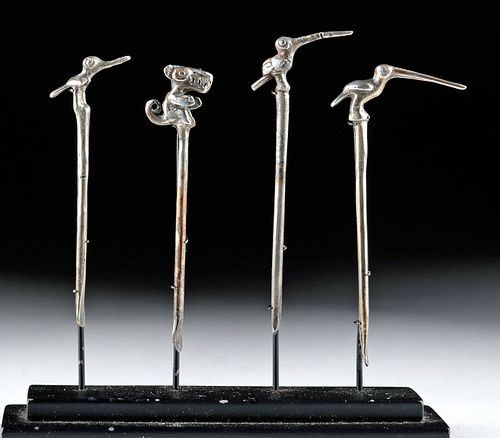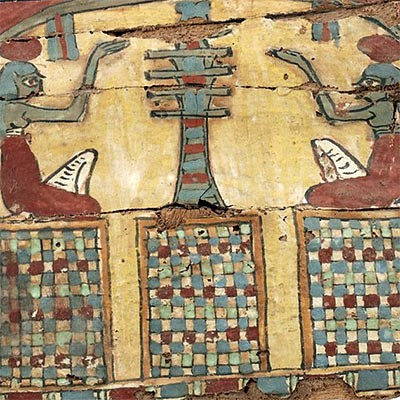Lot of 4 Moche Gilded Silver Coca Spoons
Lot 91
About Seller
Artemis Fine Arts
686 S Taylor Ave, Ste 106
Louisville, CO 80027
United States
Selling antiquities, ancient and ethnographic art online since 1993, Artemis Gallery specializes in Classical Antiquities (Egyptian, Greek, Roman, Near Eastern), Asian, Pre-Columbian, African / Tribal / Oceanographic art. Our extensive inventory includes pottery, stone, metal, wood, glass and textil...Read more
Categories
Estimate:
$1,500 - $2,000
Absentee vs Live bid
Two ways to bid:
- Leave a max absentee bid and the platform will bid on your behalf up to your maximum bid during the live auction.
- Bid live during the auction and your bids will be submitted real-time to the auctioneer.
Bid Increments
| Price | Bid Increment |
|---|---|
| $0 | $25 |
| $300 | $50 |
| $1,000 | $100 |
| $2,000 | $250 |
| $5,000 | $500 |
| $10,000 | $1,000 |
| $20,000 | $2,500 |
| $50,000 | $5,000 |
| $100,000 | $10,000 |
| $200,000 | $20,000 |
About Auction
By Artemis Fine Arts
Jul 30, 2020
Set Reminder
2020-07-30 10:00:00
2020-07-30 10:00:00
America/New_York
Bidsquare
Bidsquare : Ancient / Ethnographic From Around the World
https://www.bidsquare.com/auctions/artemis-gallery/ancient-ethnographic-from-around-the-world-5382
Ancient art from Egypt, Greece, Italy and the Near East, as well as Asian, Pre-Columbian, Native American, African / Tribal / Oceanic, Spanish Colonial, Russian Icons, Fine art, much more! All categories, all price ranges... all legally acquired and guaranteed to be as described or your money back. Artemis Fine Arts info@artemisfinearts.com
Ancient art from Egypt, Greece, Italy and the Near East, as well as Asian, Pre-Columbian, Native American, African / Tribal / Oceanic, Spanish Colonial, Russian Icons, Fine art, much more! All categories, all price ranges... all legally acquired and guaranteed to be as described or your money back. Artemis Fine Arts info@artemisfinearts.com
- Lot Description
Pre-Columbian, North Coast Peru, Moche, ca. 100 to 300 CE. A lovely group of four gilded silver coca spoons (also called lime spoons), used to prepare lime powder in order to enhance the hallucinogenic properties of other drugs. Each one has a beautiful zoomorphic/avian finial atop a long slender body hammered at the end to create a receptacle for the lime powder. Three of the spoons present hummingbird finials with characteristically long beaks and one presents a jaguar finial with an open toothy grin, perky ears, and a curled tail . Size: 3.125" H (7.9 cm); 3.5" H (8.9 cm) on included custom stand. Weight: 28.3 grams. Precious metal quality: 65% silver, 20% gold
To the ancients of the Pre-Columbian world, hummingbirds (picaflores in Spanish) were associated with the sun. Appreciated for shiny, iridescent feathering and aerial acrobatics, the hummingbird made for the ideal solar metaphor. Since these birds are known to hover, seemingly motionless, and fly up, down and even backwards, the ancients likened their motions to the sun's hovering in the sky at the solstices when it is also known to reverse its celestial direction. In addition, hummingbirds can assume a torpid state when it is cold at night or during brief periods in the winter. However, they come back to life in the spring warmth. This unique ability to "die" and "resurrect" signified rebirth to the ancients, precisely at a time when planting and, in this sense, "renewed life" occurred.
The jaguar symbolized power and might throughout the Pre-Columbian world. Warriors, rulers, hunters, and shamans alike associated themselves with this king of beasts, the largest and most powerful feline in the New World. The principal Moche god Ai apaec wears a headdress adorned with a jaguar head and paws and important mortals donned similar headdresses. A nocturnal animal, the jaguar sleeps in caves and dark places and creeps quietly in the forest, evoking great mystery. Oddly enough, few Moche artists would have actually scene jaguars as they are not indigenous to the coast. Jaguars prefer moist forest conditions. However, scholars believe that some cubs were transported over the mountains for Moche rituals, and it is also possible that some jaguars wandered down the coast.
Provenance: private Hawaii, USA collection; ex-private Hans Juergen Westermann collection, Germany, 1960s
All items legal to buy/sell under U.S. Statute covering cultural patrimony Code 2600, CHAPTER 14, and are guaranteed to be as described or your money back.
A Certificate of Authenticity will accompany all winning bids.
We ship worldwide and handle all shipping in-house for your convenience.
#145401Slight surface wear to the spoons, but the forms are generally very strong. Some loss to gilt but some still remains. Silver has developed a nice patina with small areas of green patina from the copper content.Condition
- Shipping Info
-
All shipping is handled in-house for your convenience. Your invoice from Artemis Gallery will include shipping calculation instructions. If in doubt, please inquire BEFORE bidding for estimated shipping costs for individual items.
-
- Buyer's Premium



 EUR
EUR CAD
CAD AUD
AUD GBP
GBP MXN
MXN HKD
HKD CNY
CNY MYR
MYR SEK
SEK SGD
SGD CHF
CHF THB
THB















